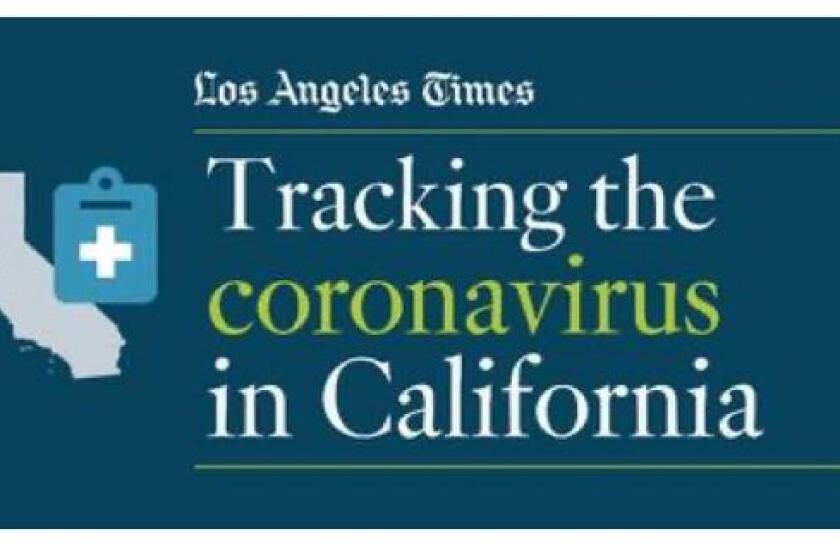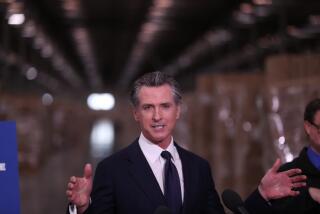In confronting coronavirus, Gov. Gavin Newsom takes California on its own path

- Share via
SACRAMENTO — When it comes to the fight against the coronavirus pandemic, Gov. Gavin Newsom has made clear he’s not concerned that California’s way may be different from that of other states.
While the arrival of the novel coronavirus has prompted governors across the country to issue sweeping statewide orders in the name of public health — legal mandates to cancel school, quarantine the sick and close down businesses — Newsom’s historic directives for the state’s 40 million residents have come with a deliberately light touch.
The Democratic governor has advised schools to consider shuttering in communities with COVID-19 cases, asked event organizers to cancel large gatherings, urged — but not ordered — bars, restaurants, movie theaters and gyms to close their doors and recommended that seniors and people with underlying health conditions shelter at home.
“We’re not some small isolated state. We’re a nation-state,” Newsom told reporters on Sunday. “Santa Clara County’s conditions are extraordinarily different than Tulare. Extraordinarily different than Madera. Or Colusa. And so, while it may be fanciful and comforting by perception standards, for some [who want] one size fits all, that’s not the world in which we view the reality on the ground. There’s no community spread in some communities, there [is] significant community spread in other communities.”
Some have questioned why Newsom isn’t being more aggressive, and whether his softer tone could put the state at a disadvantage.
The latest updates from our reporters in California and around the world
But to both Republicans and Democrats who have been part of crisis decisions made by other governors, Newsom’s approach so far looks different: They see a chief executive methodically easing Californians into a new way of life as more drastic quarantine measures begin in counties inundated with cases of the virus.
“He’s been very slow to act authoritarian,” said Rob Stutzman, a Republican consultant and former advisor to Gov. Arnold Schwarzenegger. “He’s been very intentional that these are his directives. This is what he’s asking and he’s expressing optimism that people will comply because that is how serious the situation is. In the U.S., I think that’s a very important tone to take because people will not take well to having their freedoms restricted.”
Newsom has described differences between his actions and those of other governors as a “nuance” and said California is too large and its counties are too distinct for a singular approach. As a former mayor, Newsom has repeatedly said that he’s responding with a “bottom-up” approach in a state known for a governing model that gives local leaders a wide berth to take the lead in their communities.
California’s public health system largely relies on county public health officers to respond to outbreaks. Counties have issued requirements to their residents that often go above and beyond state guidelines — something Newsom said he’s encouraged in areas hardest hit by the virus.
The state also practices a system of mutual aid during disasters, in which locals officials serve as the first line of response on the ground and look to the state to provide guidance or fill in the gaps when they need help. The state can turn to the federal government to aid in recovery, often for financial support.
Susan Kennedy, a former top aide to Govs. Gray Davis and Arnold Schwarzenegger, said the system works.
“The locals will tell you what the problems are instead of having the state coming in thinking they know how to solve the problem,” Kennedy said. “This kind of communication in the middle of a disaster is critical. We practice for if you have a gap, you ring the bell and we’re right behind you.”
Still, there have been calls for the state’s actions in the current crisis to be more bold. Leah Simon-Weisberg, legal director of the Alliance of Californians for Community Empowerment, said Newsom needs to do more to halt evictions statewide and help people who are under threat of losing their homes, especially if they aren’t working due to closures and other government action.
Newsom took action to allow cities and counties to impose moratoriums on residential evictions. Simon-Weisberg said local communities already have the power to pause evictions. She said that requiring each jurisdiction to adopt eviction bans would take too long to help everyone in need and demand a high level of intervention from advocates who are working with limited resources or are on home quarantine.
“It’s really being tone-deaf,” she said. “I just think this is when he has to be a leader and just pause all of the evictions.”
Newsom said Tuesday that he would take additional steps if he felt local jurisdictions were failing to protect their residents from eviction.
Late last week, Newsom considered statewide school closures, but ultimately opted against it and instead provided new financial aid to shuttered campuses. The vast majority of schools across the state have closed on their own, but when pressed about his lack of action, Newsom criticized some districts for moving too quickly before coming up with a plan to continue to feed low-income children.
“At this time, I don’t deal with perceptions, I deal with reality, and I deal with reality on the ground that 85% of our kids are no longer going to go to school on Monday,” Newsom said at a news conference on Sunday. “I know for a fact that not all these districts have planned for the needs of these kids next week. And I’m deeply concerned about their health. And I’m deeply concerned about their safety and we are deeply concerned about their parents’ inability to go to work.”
Newsom’s candid response highlighted the difficult calculus involved in making decisions during an unprecedented crisis — each action carries potential unintended consequences that could negatively affect the state’s most vulnerable populations.
Karen Smith, a communicable disease expert and former director of the California Department of Public Health, is among those who agreed with the governor’s decision to not shut down schools across the state.
While counties affected by COVID-19 made the decision to close on their own, it’s an unnecessary step in other parts of the state, she said.
“There are huge swaths of California where there’s no coronavirus yet,” Smith said.
Smith emphasized that closures place financial burdens on parents, including some healthcare workers, who would have to stay home without pay to care for their children. Grandparents, who are most susceptible to serious illness, also could become primary caregivers for children, putting them at risk of contracting the virus.
Smith and others say school closures, or requests to quarantine at home, should come with an expiration date or some explanation as to when residents can expect to live a normal life again.
“If you’re going to do that, because it’s going to create so much social disruption, you have to be able to articulate when you are going to decrease the restrictions,” Smith said.
During a news conference on Tuesday, Newsom advised parents not to count on schools reopening before summer break.
“This is a very sober thing to say,” Newsom said. “And I can’t say this with certainty, but I can say this quite learnedly: Don’t anticipate schools are going to open up in a week. Please don’t anticipate in a few weeks, and I say that because one needs to be honest, and I need to be accountable to you.”
Other governors, including Illinois Gov. J.B. Pritzker, Washington Gov. Jay Inslee and Ohio Gov. Mike DeWine have taken more sweeping approaches than Newsom, ordering all schools in the state shut down and bars and restaurants closed.
“We have been consulting with experts all through this every single day. And it was time,” DeWine said during a CNN interview on Thursday. “The experts told us it was time to do this. This was not something we wanted to do, particularly with the schoolchildren.”
“Our biggest concern in Ohio and this country is overtaxing our whole medical system, so we end up like, apparently, Italy is, where they’re making life-and-death decisions.”
And unlike some of his Democratic counterparts in other states, Newsom has also refrained from criticizing President Trump’s response to the pandemic, instead praising his administration’s work with the state.
“I’m working to solve problems, not create problems,” Newsom said. “I’m willing to put aside our differences on a lot of issues to meet this moment, so I can meet the needs of the people in the state of California. And I think we’re better off when we’re working partners, not sparring partners.”
Shortly after Newsom issued a directive on Sunday calling on bars to close and restaurants to enhance social distancing by cutting their dine-in clientele in half, Los Angeles Mayor Eric Garcetti went a step further. Garcetti ordered bars and nightclubs closed and limited restaurants to takeout orders until March 31. The mayor also ordered the closure of movie theaters, gyms and fitness centers.
Newsom followed late Monday by advising restaurants to close their doors to dine-in customers, asking gyms, health clubs and movie theaters to shutter and asking residents to cease gatherings.
Several counties in California have adopted broad “shelter-in-place” orders of all residents, similar to the measures that have been applied to control the virus in Italy, France, Spain and China, where infectious disease experts say it appears to be slowing the spread of the deadly disease in the epicenter of the pandemic.
On Tuesday, seven counties in the Bay Area ordered all residents to remain in their homes, foreshadowing strict requirements that could be replicated regionally or statewide as more cases of COVID-19 are confirmed in California. Sacramento County followed with a similar request for residents to stay home.
Dr. Rohan Radhakrishna, Contra Costa County deputy health officer, said local officials showed some resistance to the move, but agreed that it was the best approach. He anticipated that additional counties would follow, but said some might be slow to issue mandatory orders without confirmed cases.
“If transmission is high enough, that starts to leak out — especially in L.A. or the Bay Area where you can’t tell where one city ends and the next one begins,” said Smith, who led the state public health department under former Gov. Jerry Brown and is working as a consultant in Santa Clara and Mendocino counties. “I used to run scenarios like this all the time and I just never expected it to happen while I’m working and part of it.”
Newsom said Sunday that he didn’t see a need to mandate a statewide quarantine yet.
“If you want to establish a framework of martial law, which is ultimate authority enforcement, we have the capacity to do that,” Newsom said Sunday. “But we are not at this moment feeling that is a necessity.”
Days later, he warned that the state reserves “the right to go further if we don’t think the local efforts are meeting the moment.”
Under the authority of the Emergency Services Act, the governor possesses widespread power to respond during a state of emergency such as a pandemic, said Stephen M. Duvernay, senior research fellow at Berkeley Law’s California Constitution Center.
The governor has authority to commandeer private property, including hospitals, medical labs, hotels and motels, and put them under the state’s authority — something Newsom authorized state agencies to do in an executive order issued last week.
The governor also has the authority to suspend state regulations. For example, after the 1994 Northridge earthquake Gov. Pete Wilson suspended regulations under the California Environmental Quality Act — a nearly half-century-old law that requires developers to disclose a project’s environmental effects and take steps to reduce or eliminate them — to speed up the recovery efforts.
Newsom has the authority to redirect state funds to help in an emergency, even funds appropriated by the California Legislature for an entirely different purpose.
Along with the power to quarantine during a state of emergency, California law gives state health officials — who answer to the governor — the authority to “quarantine, isolate, inspect, and disinfect persons, animals, houses, rooms, other property, places, cities, or localities, whenever in its judgment the action is necessary to protect or preserve the public health.”
The law also allows health officials to “take possession or control of the body of any living person, or the corpse of any deceased person” to prevent the spread of a contagious disease. State health officials can require the sheriff of each county to enforce orders.
Newsom used his authority in a historic step on Tuesday to direct the National Guard to be prepared to perform humanitarian missions across the state, which he described as overseeing food distribution and ensuring people aren’t hoarding food at grocery stores.
Through the state agencies under his control, Newsom has authority to call in the national guard to police cities, set curfews, suspend licenses to sell liquor and other services. Under the state’s health and safety code, Newsom could also have people arrested and quarantined in their homes, said Kevin Eckery, who served as a senior aide to Wilson.
Eckery praised Newsom for avoiding a “draconian” response, saying his decision to issue voluntary directives has proven to largely be effective.
“The power is there. But the problem is that when you exercise that authority, then you have to enforce it,” Eckery said. “If you can get almost all the way there through social pressure, peer pressure, then that frees up a lot of resources for other things.”
Eckery said that during his time in the Wilson administration in the 1990s, the governor issued 27 declarations of emergency, including during the 1994 Northridge earthquake, the AIDS epidemic, the 1992 Los Angeles riots and the Mediterranean fruit fly infestation.
The California National Guard patrolled the streets of L.A. after the riots broke out, and aided Californians displaced by the Northridge quake, Eckery said. But Eckery and others agree that the threat of the coronavirus and the state’s response is unprecedented in California’s modern history.
“The governor can call in the National Guard, the governor can use them in any police function. He can call for curfews. He can call for quarantines,” Eckery said. “It’s not something that should be used willy-nilly. It’s something he should only use when he needs it — but not before it’s necessary and not when it’s too late.”
More to Read
Sign up for Essential California
The most important California stories and recommendations in your inbox every morning.
You may occasionally receive promotional content from the Los Angeles Times.














